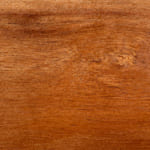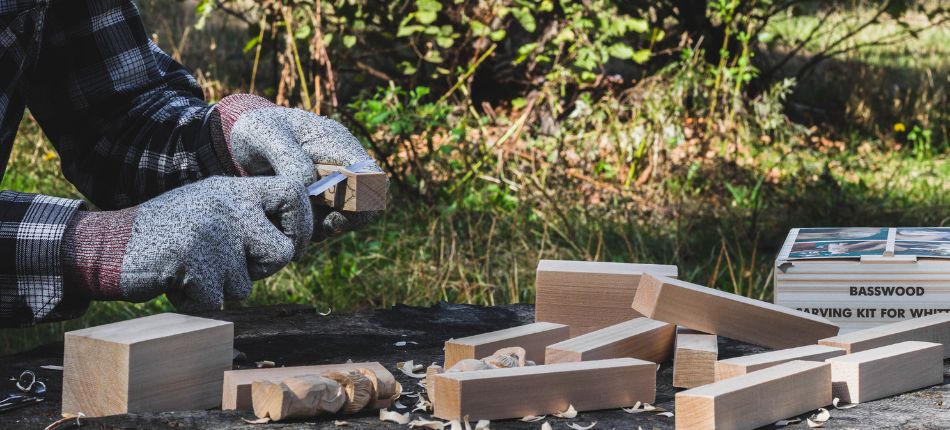Best Wood for Wood Carving

Any beginner wood carver can face the problem of choosing the best wood for carving. The material in this craft is critical. All your creative enthusiasm can cool off if you pick the wrong wood. If you're unsure what types of wood to use for your woodcarving projects, this guide will help you decide.
Green and Dried Wood: Know the Difference
It is possible to carve any wood – green (freshly cut) or dried (seasoned) – the choice is yours. The main thing is to remember all the features of each of them. The ability to work with both kinds of wood frees the carver to choose any theme of the project, and the plot for carving, creating favorable conditions for experiments.
No matter what wood for carving you choose – fresh or dried – it must be of good quality, without cross-layers and knots. In such conditions, it does not break, crack, or chip.

Pros and cons of Green Wood for Carving
Working with green (wet) wood for carving can offer several advantages and disadvantages for wood carvers. Here are the main:
|
✅ Advantages
|
❌ Disadvantages
|
|
Easier to carve
|
Increased moisture content
|
|
Reduced risk of splitting
|
Longer drying time
|
|
Greater workability
|
Risk of checking and cracking
|
|
Lower tool wear
|
Difficulty in achieving precise dimensions
|
|
Enhanced wood grain visibility
|
Increased susceptibility to decay
|
|
Immediate access to freshly felled wood
|
|
It's important to remember that green wood will eventually dry and shrink, which may cause slight changes in the size and shape of the carving over time. Proper drying and curing techniques may be necessary to stabilize the wood and prevent excessive warping or cracking.
Understanding and mitigating these pros and cons through proper drying techniques, careful handling, and thoughtful design considerations can help minimize the potential drawbacks of working with green wood for carving.
Pros and cons of Dry Wood for Carving
Carving with dried (dry) wood offers a lot of advantages but there are also some potential disadvantages to consider:
|
✅ Advantages
|
❌ Disadvantages
|
|
Stability
|
Hardness
|
|
Predictable characteristics
|
Limited flexibility
|
|
Reduced risk of checking and splitting
|
Potential for wood movement
|
|
Increased hardness
|
Preservation challenges
|
|
Improved workability
|
|
|
Wider wood selection
|
|
It's essential to keep in mind that proper storage conditions are crucial to maintaining its dryness and preventing the reabsorption of moisture. Storing dried wood in a controlled environment can help preserve its qualities and ensure optimal carving conditions.
By understanding and addressing these pros and cons, wood carvers can adapt their carving techniques, choose suitable wood species, and implement proper preservation measures to overcome challenges associated with working with dried wood.
How to Choose Dry Wood or Green Wood?
Green wood allows you to perform more technically complex projects that will be more difficult to make from dry wood. This type of wood has enough advantages: it is suitable for beginners as it is easy to carve and practice various cuts. Moreover, you can gather it from a forest or park near your house.
One of the disadvantages of green wood for carving is the high amount of moisture that can cause your crafts to crack when dried. It also leaves marks on your tools, making them difficult to clean.
Many wood species are better to carve dry as they have better stability. And there are many reasons for this. Wood crafts carved from dry wood do not crack and do not change shapes and overall dimensions. Dry wood is versatile as it is suitable for all skill levels – from beginners to advanced. It is great for projects with fine details and perfectly soaks in the paint.

As great as dry wood for carving is, it also has drawbacks – it is a bit difficult to cut and may require a more extensive set of tools for carving.
How to Choose Wood for Your Projects: Simple Beginner Guide
Whether you decide to carve a simple caricature, animal figure, or an original decor piece, you need to know the best wood to carve for beginners. Different types have different properties and color shades, so every beginner should consider the following nuances when choosing high-quality wood for carving:
- Wood species;
- Safety of use (some woods are toxic, so they are not safe to work with);
- Softness/hardness (flexibility);
- Integrity (avoid wood with defects, such as knots and cracks);
- Moisture content (too wet or too dry wood is not suitable for carving);
- Density/strength (ease of processing).
Choosing the best wood to carve for beginners will depend on personal preference and the design of the project you want to complete. However, if you are just getting started in the craft and are likely to make mistakes, it is best to choose some of the least expensive woods, such as soft linden (basswood), aspen, butternut, or white pine. These woods are easy to work with and will not wear down your tools quickly.
The proper wood type means a lot in wood carving. If you are fond of sculptural carving, it is better to use durable wood species like oak, aspen, cedar, etc. Use basswood, birch, and alder for relief or chip carving. They are soft and flexible.
The Most Popular Types of Wood Among Carvers
Usually, the most popular wood types for wood carving are also the best and easiest to carve. Here is a list of wood types that are highly favored by users of beavercrafttools.com :

Walnut
Walnut wood, known for its exquisite appeal and moderate hardness, captures the hearts of woodworking enthusiasts worldwide. Its distinguished grain pattern and rich tones make it a favored choice for furniture making and decorative crafts. Curious about its carving properties? Dive into our enlightening article, «Is Walnut Wood Hard to Carve?».

Acacia
Acacia wood, with its captivating grain pattern and moderate hardness, is a favorite among woodworking enthusiasts. Its versatility shines in furniture making and decorative pieces. Curious about its carving potential? Read our article, «Is Acacia Wood Hard to Carve?» and discover the allure of this remarkable material.

Alder
Alder wood, with its distinct charm and moderate hardness, has carved a special place in the world of woodworking. Its subtle grain patterns and warm tones make it a popular choice for both furniture and cabinetry projects. If you're curious about its carving capabilities, look no further than our insightful article, «Is Alder Wood Hard to Carve?» Immerse yourself in the world of alder wood, unleash your creativity, and unlock its endless potential.

Elm
Elm wood, with its timeless beauty and moderate hardness, captivates woodworking enthusiasts around the globe. The intricate grain patterns and rich hues of elm make it a sought-after choice for furniture and flooring applications. If you're curious about its carving characteristics, our enlightening article, «Is Elm Wood Hard to Carve?» holds the answers you seek.

Basswood (linden)
Known for its widespread presence across Europe and the Americas, this versatile white wood has been cherished by craftsmen for centuries. With its minimal grain and softness, basswood proves to be an excellent choice for novice woodworkers. If you're eager to learn the art of carving, basswood blanks are readily available and offer an ideal starting point. Uncover the truth behind the question «Is Basswood Hard to Carve?» by reading our compelling article now.
To ensure that you make an informed wood carving choice, we recommend checking out our guides, «What Is the Softest Wood for Carving?» and «Which Type of Wood is Best for Beginners?». These guides will assist you in selecting the most suitable wood for your wood carving endeavors.
Good Places to Get the Finest Wood
As you see, making the first steps in wood carving requires working with soft wood first. Many professional carvers recommend starting with linden, also known as basswood or limewood. So, the question is, where to buy wood for carving if you are a beginner? What places are the best? It's a dilemma nearly every whittler will face.
There are lots of places where you can stock good wood for your beginner whittling projects. If you like buying craft supplies offline, you can check a local sawmill (if you have one near you), hardware store, or woodcraft store. But if you want to shop from the comfort of your home, check out the popular online woodworking shops or craft retailers.

Are you still struggling to choose? At BeaverCraft, you will find exceptional quality wood – basswood carving blocks and blanks for beginners in various sizes and quantities – no knots, no cracks, delivered right to your doorstep.
Our wood blocks are made of natural Basswood; they are light in color and have a smooth surface and nice texture. They are soft and easy to carve and paint. If you plan to create a project with lots of detail, BeaverCraft kits of basswood carving blocks will become your go-to choice.

Of course, you can carve exotic, rare, and precious woods like black walnut, mahagony, sandalwood, or even jarrah. These woods have a unique appearance, inimitable properties, and, of course, a high price. Due to color, texture, strength, and other characteristics, exotic woods remain popular in many woodworking industries.
Professional carvers work with different woods. To find the best wood for carving, an ultimate solution for beginner carvers, you must experiment, expand your skills and grow your carving experience.
Best Wood for Wood Carving FAQ
What is the best wood for carving?
The best wood for carving depends on factors such as personal preference and the specific requirements of your project. However, some woods commonly favored by woodcarvers include basswood, butternut, mahogany, cherry, oak, walnut, and cedar. These woods are known for their relatively soft texture, ease of carving, and attractive grain patterns.
Where can I buy wood for carving?
When looking to purchase wood for carving, there are several options available to you. Specialty woodworking stores often carry a variety of carving woods, providing a wide selection to choose from. Additionally, you can explore online retailers that offer a range of carving wood options and have them delivered to your doorstep. Local sawmills are another potential source, as they may sell specific carving woods or have rough-cut lumber that you can shape and carve yourself.
What wood is good for carving?
Many wood species are suitable for carving, and the choice depends on your personal preference and the specific carving project. Some popular choices among woodcarvers include basswood, butternut, mahogany, cherry, oak, walnut, and cedar. These woods tend to have favorable characteristics such as moderate hardness, straight grain, and few prominent knots. They are generally easier to work with and can provide visually appealing results.
How do I prepare wood for carving?
Preparing wood for carving involves a few essential steps. First, it's important to select the right wood species for your project, considering factors such as hardness and grain pattern. Once you have your wood, you can start by rough shaping it using saws, chisels, or carving knives to remove excess material and establish the basic shape of your carving. Next, remove any bark using a chisel or drawknife, and smooth the wood surface by sanding with sandpaper or sanding blocks. This helps ensure a clean and even surface for carving.



4 Comments
That’s amazing to hear! 🙌 Pushing your limits is where the real magic happens. Can’t wait to see what you create — world-class starts with one bold cut! 💪
Is dried Polar wood good for wood carvings?
That’s amazing — thanks for sharing! It’s great to hear you’ve built up that confidence. Can’t wait to see what you create next — going for something world-class is a big and exciting step!